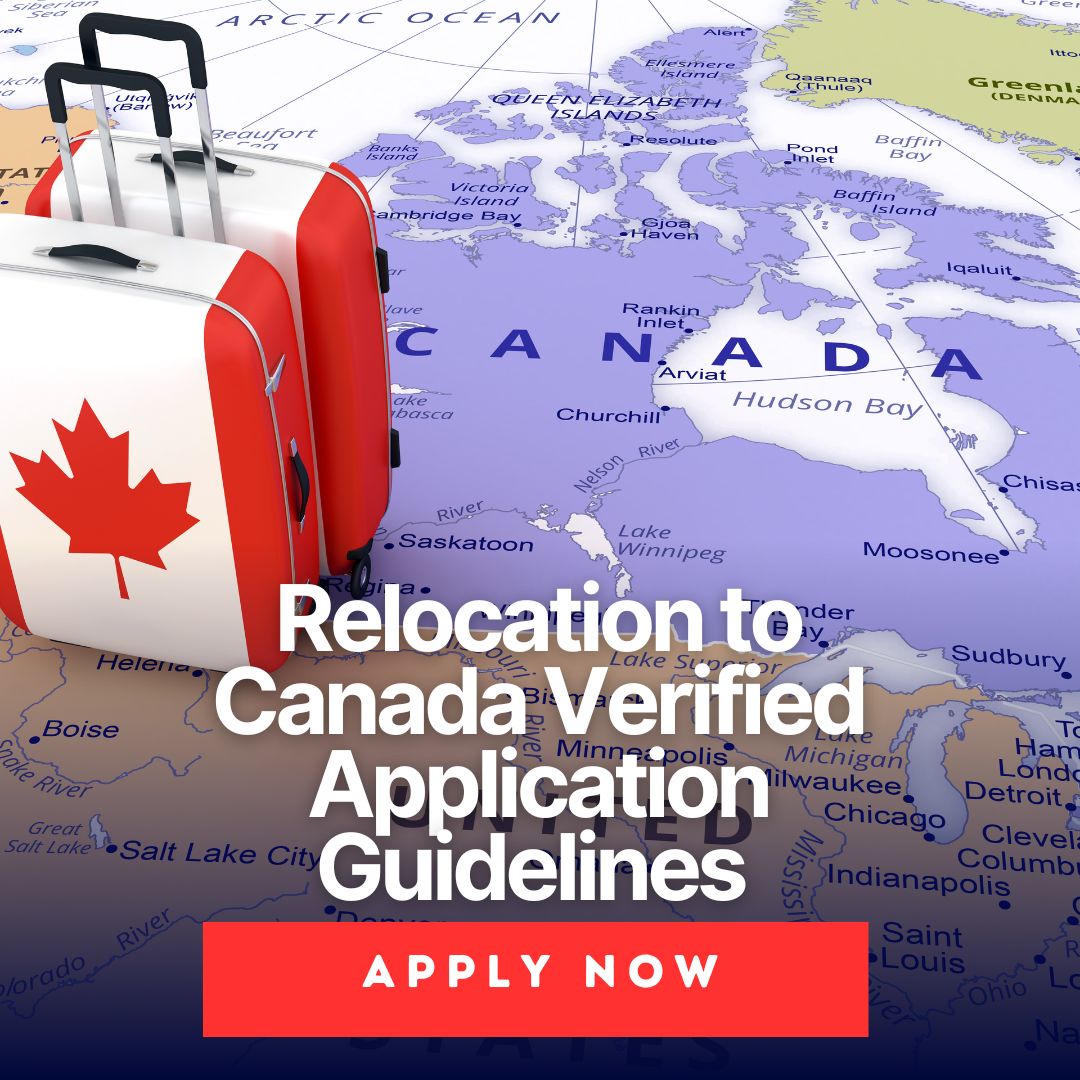Relocation to Canada – Canada has long been a beacon for individuals seeking a fresh start in a nation renowned for its inclusivity, high standard of living, and stunning natural beauty. As 2025 unfolds, Canada continues to be a top destination for immigrants from around the world, offering numerous opportunities for those looking to call it home.
However, with various immigration pathways and evolving policies, navigating the relocation process can be complex. This comprehensive guide is here to help.
Whether you’re considering the Express Entry program, exploring a Provincial Nominee Program (PNP), or other pathways, this article will provide verified guidelines to assist you in making the move to Canada in 2025.
Why Relocate to Canada in 2025?
Relocating to another country is a significant decision, and understanding why Canada remains an attractive option in 2025 is crucial. Let’s explore the benefits of living in Canada and the recent changes in immigration policy that make this year an ideal time to consider the move.
Relocation to Canada: Relocation Guidelines in Canada
Imagine living in a country where universal healthcare is a given, the education system is world-class, and the environment is clean and safe. That’s Canada in a nutshell. Consistently ranked as one of the most livable countries globally, Canada offers a high quality of life that appeals to people from all walks of life.
Canada’s healthcare system is publicly funded, ensuring that residents have access to essential medical services without the financial burden. Education is another significant draw, with Canadian universities frequently ranking among the best in the world. For families, Canada’s commitment to quality education at all levels is a major advantage.
Moreover, Canada’s natural beauty is unparalleled. From the majestic Rocky Mountains to the serene Great Lakes, the country offers an abundance of outdoor activities for nature enthusiasts. Whether skiing in Whistler, hiking in Banff, or enjoying urban parks in Toronto, there’s something for everyone.
Economically, Canada is a stable nation with a strong job market. Sectors such as technology, healthcare, and engineering are particularly robust, offering numerous opportunities for skilled workers. Additionally, Canada’s commitment to diversity and inclusion makes it a welcoming place for immigrants, allowing for easier integration into society.
For more detailed information on living in Canada, visit the official Government of Canada website.
Relocation To Canada – Changes in Canadian Immigration Policy for 2025
Every year, Canada adjusts its immigration policies to better align with its economic and social needs. In 2025, several key changes have been implemented that potential immigrants should be aware of.
One of the most significant changes is the increase in Canada’s annual immigration targets. The government aims to welcome over 400,000 new permanent residents this year, reflecting the country’s commitment to growth and diversity. This increase means that more opportunities are available for those looking to immigrate.
Additionally, the points system used in the Express Entry program has been updated to better reflect the needs of Canada’s labor market. For example, more points are now awarded for Canadian work experience and language proficiency, making it easier for those already familiar with the country to qualify.
Another notable change is the expansion of Provincial Nominee Programs (PNPs). Provinces now have greater autonomy to select candidates who meet their specific labor market needs. This change is particularly beneficial for those who have a specific province in mind for relocation.
These policy changes make 2025 an exciting year for those considering a move to Canada. However, staying informed and understanding which pathway best suits your situation is essential.
Understanding the Various Immigration Pathways For Relocation To Canada
Immigrating to Canada isn’t a one-size-fits-all process. The country offers various pathways depending on your skills, family ties, or business ambitions. Understanding which path suits you best is the first step toward making Canada your new home.
Express Entry Program
The Express Entry system is the most popular pathway for skilled workers aiming to immigrate to Canada. Introduced in 2015, Express Entry has streamlined the immigration process, making it faster and more efficient. But did you know that Express Entry is actually an umbrella system that manages applications for three different immigration programs?
Federal Skilled Worker Program
The Federal Skilled Worker Program (FSWP) is designed for individuals with significant work experience, education, and skills that are in demand in Canada. If you’re a professional in fields such as engineering, healthcare, or information technology, this program could be your golden ticket to Canada.
To qualify for the FSWP, you need to meet certain criteria, including a minimum of one year of continuous full-time work experience in a skilled occupation, proficiency in English or French, and a valid educational credential. The FSWP operates on a points-based system, where candidates are scored based on factors like age, education, work experience, and language ability. The higher your score, the better your chances of being invited to apply for permanent residence.
Canadian Experience Class
The Canadian Experience Class (CEC) is tailored for individuals who have already spent time working or studying in Canada. If you’ve gained Canadian work experience through a temporary work permit or have completed a post-secondary program in Canada, this program might be your best option.
The CEC recognizes the value of Canadian experience and offers a faster route to permanent residence for those who have already adapted to life in Canada. To qualify, you need at least one year of skilled work experience in Canada, along with proficiency in English or French. The CEC does not require candidates to meet the same educational criteria as the FSWP, making it a more accessible option for those who have already established themselves in Canada.
Federal Skilled Trades Program
The Federal Skilled Trades Program (FSTP) is a specialized pathway for individuals with expertise in skilled trades such as plumbing, carpentry, welding, and electrical work. Canada’s growing economy has a strong demand for skilled tradespeople, and the FSTP is designed to meet this need.
To qualify for the FSTP, you must have at least two years of full-time work experience in a skilled trade within the past five years. Additionally, you need to have a valid job offer from a Canadian employer or a certificate of qualification in your trade issued by a Canadian province or territory. Language proficiency in English or French is also required, although the thresholds are lower compared to other Express Entry programs.
Provincial Nominee Programs (PNPs)
Canada’s provinces and territories have their own immigration needs, which is why the Provincial Nominee Programs (PNPs) were established. PNPs allow provinces to nominate candidates who meet their specific labor market requirements for permanent residence.
Each province has its own set of criteria and streams within its PNP. For example, some provinces prioritize candidates with work experience in certain industries, while others focus on entrepreneurs and investors. If you have a specific province in mind, applying through a PNP could fast-track your immigration process.
The PNP process typically involves two steps: first, you apply for a provincial nomination, and if you’re successful, you then apply for permanent residence through the federal government. PNPs are a great option if you have ties to a particular province, such as a job offer, family members, or previous experience living there.
Family Sponsorship
Canada values family reunification, and the Family Sponsorship program allows Canadian citizens and permanent residents to sponsor their relatives for immigration. If you have a close family member who is a Canadian citizen or permanent resident, they may be able to sponsor you for permanent residence.
Eligible family members include spouses, common-law partners, dependent children, parents, and grandparents. The sponsor must be willing to support the sponsored family member financially and ensure they do not require social assistance from the government.
Family Sponsorship is a relatively straightforward pathway, but it requires a strong relationship with the sponsor and a commitment to the sponsorship responsibilities. If you’re considering this option, it’s important to ensure that both you and your sponsor meet the eligibility criteria.
Business Immigration
Canada also welcomes entrepreneurs, investors, and self-employed individuals through various business immigration programs. If you have a viable business idea, significant investment capital, or skills in cultural or athletic activities, Canada offers pathways to permanent residence tailored to your needs.
Start-Up Visa Program
The Start-Up Visa Program is designed for innovative entrepreneurs who have the potential to build businesses in Canada that can create jobs and compete on a global scale. To qualify, you must have a business idea supported by a designated organization, such as a venture capital fund, angel investor group, or business incubator.
In addition to securing support from a designated organization, you need to meet language proficiency requirements in English or French and demonstrate that you have enough funds to settle in Canada. The Start-Up Visa Program is an excellent option for entrepreneurs looking to bring their innovative ideas to Canada and contribute to the economy.
Self-Employed Persons Program
The Self-Employed Persons Program is tailored for individuals with experience in cultural or athletic activities who can make a significant contribution to Canada’s cultural or sporting life. If you’re an artist, musician, writer, or athlete, this program could be your pathway to permanent residence.
To qualify, you need to have relevant experience in cultural or athletic activities, demonstrate the ability to be self-employed in Canada, and meet the program’s selection criteria. The Self-Employed Persons Program recognizes the unique contributions that artists and athletes can make to Canadian society and offers a specialized pathway for these individuals.
Study Permits and Post-Graduation Work Permits
Canada is home to some of the world’s top universities and colleges, making it a popular destination for international students. If you’re considering studying in Canada, obtaining a study permit is the first step. A study permit allows you to live and study in Canada for the duration of your program.
One of the major advantages of studying in Canada is the opportunity to apply for a Post-Graduation Work Permit (PGWP) after completing your studies. The PGWP allows you to work in Canada for up to three years, gaining valuable work experience that can help you qualify for permanent residence through the Canadian Experience Class.
If you’re planning to study in Canada, it’s important to understand the requirements for both the study permit and the PGWP. This pathway offers a unique opportunity to gain Canadian education and work experience, which can significantly enhance your prospects for permanent residence.
Step-by-Step Guide to Applying for Canadian Immigration
Now that you have a better understanding of the different immigration pathways, let’s dive into the step-by-step process of applying for Canadian immigration. Whether you’re applying through Express Entry, a PNP, or another program, following these steps will help you navigate the process with confidence.
Assessing Your Eligibility
Before you begin the application process, it’s essential to assess your eligibility for the various immigration programs. Each program has specific criteria, such as work experience, education, language proficiency, and financial stability.
Start by researching the requirements for the program you’re interested in. For example, if you’re applying through the Federal Skilled Worker Program, you’ll need to meet the minimum points threshold on the Comprehensive Ranking System (CRS). If you’re applying through a PNP, check the eligibility criteria for the specific stream you’re interested in.
Once you have a clear understanding of the eligibility requirements, take an honest assessment of your qualifications. This will help you determine which program you’re most likely to qualify for and whether you need to take any additional steps, such as improving your language skills or gaining more work experience.
Preparing the Necessary Documents
The next step in the immigration process is preparing the necessary documents. The specific documents required will depend on the program you’re applying for, but common documents include:
- Proof of identity: Passport or other government-issued identification.
- Educational credentials: Diplomas, degrees, and transcripts.
- Language test results: IELTS, CELPIP, or TEF scores.
- Work experience documents: Reference letters from employers, pay stubs, and job contracts.
- Proof of funds: Bank statements or other financial documents demonstrating that you have enough money to support yourself and your family in Canada.
- Police certificates: Background checks from every country you’ve lived in for six months or more since the age of 18.
- Medical exams: Proof that you and your family members are in good health.
It’s crucial to gather all the required documents before submitting your application, as incomplete applications can lead to delays or even rejection. Make sure your documents are up-to-date and accurately reflect your qualifications.
Submitting Your Application
Once you’ve gathered all the necessary documents, it’s time to submit your application. The process for submitting your application will vary depending on the program you’re applying for.
How to Create an Express Entry Profile
If you’re applying through the Express Entry system, you’ll need to create an online profile on the Immigration, Refugees and Citizenship Canada (IRCC) website. Your profile will include information about your work experience, education, language proficiency, and other relevant details. Based on this information, you’ll be assigned a CRS score.
Once your profile is complete, you’ll enter the Express Entry pool, where you’ll be ranked against other candidates. If your CRS score is high enough, you’ll receive an Invitation to Apply (ITA) for permanent residence. It’s important to ensure that all the information in your profile is accurate and complete, as discrepancies can result in your application being refused.
Tips for a Successful Provincial Nominee Application
If you’re applying through a PNP, the process will involve two stages: first, applying for a provincial nomination, and then applying for permanent residence through the federal government. Each province has its own application process, so it’s important to follow the specific guidelines provided by the province you’re interested in.
To increase your chances of success, make sure your application is tailored to the province’s specific needs. For example, if the province is looking for candidates with experience in a particular industry, highlight your relevant experience and skills. Additionally, ensure that your application is complete and free of errors, as incomplete or incorrect applications can lead to delays.
Waiting for a Decision
After you’ve submitted your application, the waiting game begins. Processing times can vary depending on the program and the volume of applications, so it’s important to be patient.
Understanding Processing Times
Processing times for Canadian immigration applications can range from a few months to over a year, depending on the program. For example, Express Entry applications are typically processed within six months, while PNP applications may take longer due to the two-stage process.
It’s important to check the estimated processing times for your specific program on the IRCC website. Keep in mind that processing times are only estimates, and actual times may vary based on factors such as the completeness of your application and the current volume of applications.
What to Do if Your Application is Delayed
If your application is taking longer than expected, there are a few steps you can take to address the delay. First, check the status of your application online through your IRCC account. If your application is still in process, there may be no need to worry, as delays can be caused by a variety of factors, such as background checks or additional document requests.
If you’re concerned about the delay, you can contact IRCC directly for more information. In some cases, you may be asked to provide additional documents or information to help expedite the process. It’s important to respond promptly to any requests from IRCC to avoid further delays.
Receiving Your Confirmation of Permanent Residence (COPR)
If your application is approved, you’ll receive a Confirmation of Permanent Residence (COPR) document, which is your official proof of permanent resident status in Canada. The COPR will include important information such as your personal details, the date you became a permanent resident, and any conditions of your status.
Once you receive your COPR, you’ll need to complete the landing process to officially become a permanent resident of Canada. This involves presenting your COPR and passport to a border services officer at a Canadian port of entry or at an inland IRCC office. After completing the landing process, you’ll receive your Permanent Resident (PR) card, which serves as your official proof of status in Canada.
Preparing for Your Move to Canada
Relocating to Canada involves more than just obtaining permanent resident status. You’ll also need to prepare for the practical aspects of moving to a new country, such as finding a place to live, understanding the cost of living, and navigating the healthcare system.
Finding a Place to Live
One of the first steps in preparing for your move to Canada is finding a place to live. Whether you’re planning to rent or buy a home, it’s important to research the housing market in your chosen city or province.
If you’re renting, consider factors such as proximity to work or school, access to public transportation, and the availability of amenities like grocery stores and parks. Rental prices can vary significantly depending on the location, so it’s important to set a budget and stick to it.
If you’re planning to buy a home, it’s a good idea to work with a real estate agent who is familiar with the local market. They can help you find properties that meet your needs and guide you through the buying process. Keep in mind that buying a home in Canada involves additional costs, such as property taxes, home inspection fees, and closing costs.
Understanding the Cost of Living in Canada
The cost of living in Canada can vary depending on the city or province you choose to live in. Major cities like Toronto and Vancouver tend to have higher living costs, while smaller cities and rural areas are more affordable.
Key expenses to consider include housing, groceries, transportation, and healthcare. While Canada’s healthcare system is publicly funded, some services, such as dental care and prescription medications, may not be covered by provincial health insurance plans. It’s a good idea to budget for these additional expenses.
When planning your budget, it’s also important to consider the cost of utilities, such as electricity, water, and internet, as well as other essentials like clothing and entertainment. Having a clear understanding of the cost of living in your chosen area will help you manage your finances effectively and ensure a smooth transition to your new life in Canada.
Navigating the Canadian Healthcare System
Canada’s healthcare system is one of the best in the world, offering high-quality care to all residents. However, it’s important to understand how the system works and what services are covered.
Each province and territory in Canada has its own health insurance plan, which covers medically necessary services such as doctor visits, hospital stays, and surgeries. To access these services, you’ll need to apply for a provincial health card once you arrive in Canada.
While the majority of healthcare services are covered by provincial plans, some services, such as dental care, prescription medications, and vision care, may not be covered. It’s a good idea to consider purchasing private health insurance to cover these additional costs.
It’s also important to familiarize yourself with the process of finding a family doctor and accessing specialist care if needed. In some provinces, there may be a waiting period before you’re eligible for health coverage, so it’s important to have temporary health insurance in place during this time.
Enrolling Your Children in School
If you’re moving to Canada with children, one of your top priorities will be enrolling them in school. Canada’s education system is renowned for its quality, offering a wide range of programs and opportunities for students of all ages.
In Canada, education is publicly funded and free for children from kindergarten through grade 12. Each province and territory is responsible for its own education system, so there may be variations in curriculum, school hours, and grading systems.
To enrol your child in school, you’ll need to provide proof of residency, such as a lease agreement or utility bill, as well as your child’s birth certificate and immunization records. It’s a good idea to contact the local school board in your area to find out about enrolment requirements and deadlines.
Canada also offers a variety of extracurricular activities, such as sports, music, and arts programs, which can help your child build social connections and develop new skills. Encouraging your child to participate in these activities can help them adjust to their new environment and make the transition to life in Canada easier.
Setting Up Your Finances in Canada
When you move to Canada, it’s important to set up your finances to ensure a smooth transition. This includes opening a Canadian bank account, applying for a credit card, and understanding the tax system.
Opening a bank account in Canada is a straightforward process, and most banks offer a variety of account options to suit your needs. It’s a good idea to choose a bank that has branches and ATMs near your home or workplace for convenience.
Applying for a credit card is also important, as it can help you build a credit history in Canada. A good credit history is essential for renting a home, applying for loans, and making large purchases. When applying for a credit card, be sure to choose one with a low-interest rate and no annual fee.
Understanding the Canadian tax system is also crucial. Canada has a progressive tax system, meaning that your tax rate increases as your income increases. It’s important to keep track of your income and expenses throughout the year to ensure you’re prepared for tax season.
You may also want to consider setting up a Registered Retirement Savings Plan (RRSP) or a Tax-Free Savings Account (TFSA) to help you save for the future. These accounts offer tax advantages and can help you achieve your financial goals in Canada.
Settling in Canada: What to Expect After Relocation to Canada
Relocating to Canada is an exciting adventure, but it’s also a significant adjustment. Understanding what to expect after you arrive can help you settle in more smoothly and make the most of your new life in Canada.
Adapting to Canadian Culture
Canada is known for its multicultural society, where people from all backgrounds are welcomed and respected. However, adapting to a new culture can take time, especially if you’re moving from a country with different customs and traditions.
One of the first things you’ll notice about Canadian culture is the emphasis on politeness and respect for others. Canadians are known for their friendliness and courtesy, and it’s important to reciprocate these values in your interactions with others.
Canada also has a strong sense of community, and getting involved in local activities or volunteer opportunities is a great way to meet new people and build connections. Whether you join a sports team, attend cultural events, or participate in community organizations, engaging with your new community can help you feel more at home.
It’s also important to be open to learning about Canadian customs and traditions, such as celebrating Canada Day on July 1st or enjoying a winter pastime like ice skating. Embracing these aspects of Canadian culture can enrich your experience and help you feel more connected to your new home.
Building a Social Network
Moving to a new country can be challenging, especially when it comes to building a social network. However, Canada offers numerous opportunities to meet new people and make friends.
One of the best ways to build a social network is to get involved in activities that interest you. Whether it’s joining a local sports league, taking a cooking class, or participating in a book club, there are plenty of ways to connect with others who share your interests.
Social media can also be a valuable tool for meeting new people and staying connected with your community. Platforms like Facebook, Meetup, and LinkedIn offer groups and events where you can meet like-minded individuals and expand your social circle.
Don’t be afraid to reach out and introduce yourself to your neighbours, coworkers, and classmates. Canadians are generally welcoming and open to meeting new people, so taking the initiative to start conversations can go a long way in building relationships.
Understanding Employment Opportunities
Canada’s economy is diverse and offers a wide range of employment opportunities across various industries. Whether you’re a skilled professional, a tradesperson, or an entrepreneur, there are plenty of job prospects in Canada.
If you’re looking for work in Canada, it’s important to start your job search early and be prepared to adapt to the Canadian job market. This may involve updating your resume to match Canadian standards, obtaining the necessary certifications or licenses for your profession, and networking with potential employers.
Job search websites like Indeed, LinkedIn, and Workopolis are great resources for finding job opportunities in Canada. You can also attend job fairs and networking events to connect with employers and learn more about the job market in your area.
If you’re interested in starting your own business, Canada offers a supportive environment for entrepreneurs, with various programs and resources available to help you get started. Whether you’re launching a tech startup, opening a small business, or investing in a franchise, Canada’s business-friendly policies make it an ideal place to pursue your entrepreneurial dreams.
Exploring Permanent Residence and Citizenship Options
Once you’ve settled in Canada and are enjoying your new life, you may want to explore the options for obtaining permanent residence or citizenship. While becoming a permanent resident is a significant milestone, obtaining Canadian citizenship offers additional benefits, such as the right to vote and access to certain government jobs.
To be eligible for Canadian citizenship, you must have lived in Canada as a permanent resident for at least three out of the last five years. You’ll also need to demonstrate proficiency in English or French, pass a citizenship test on Canadian history and government, and meet other requirements.
If you’re considering applying for citizenship, it’s important to start preparing early by studying for the citizenship test and gathering the necessary documents. The citizenship application process can take several months, so it’s a good idea to apply well before you need your citizenship status.
Becoming a Canadian citizen is a proud achievement and a testament to your commitment to your new home. Whether you’re planning to stay in Canada long-term or exploring your options for the future, pursuing citizenship is a rewarding step in your immigration journey.
Conclusion On Relocation to Canada Verified Application Guidelines
Relocating to Canada in 2025 is more than just a change of address; it’s a step towards a new life filled with opportunities. By understanding the verified guidelines, choosing the right immigration pathway, and preparing thoroughly, you’ll be well on your way to making Canada your new home. Remember, the journey might be long, but the destination is well worth it.
Frequently Asked Questions About Relocating to Canada in 2025
- What is the easiest way to immigrate to Canada in 2025? The easiest way to immigrate to Canada depends on your qualifications and circumstances. For skilled workers, the Express Entry program is often the fastest and most efficient pathway. For those with family ties in Canada, the Family Sponsorship program may be the best option.
- How long does it take to process a Canadian immigration application? Processing times for Canadian immigration applications vary depending on the program and the volume of applications. Express Entry applications are typically processed within six months, while Provincial Nominee Programs may take longer.
- Can I bring my family with me when I immigrate to Canada? Yes, most Canadian immigration programs allow you to include your spouse or common-law partner and dependent children in your application. Family Sponsorship programs are specifically designed to help reunite families in Canada.
- What are the costs associated with relocation to Canada? The costs of relocating to Canada can include application fees, language tests, medical exams, and proof of funds. Additionally, you’ll need to budget for housing, transportation, and other living expenses once you arrive.
- What should I do if my immigration application is rejected? If your immigration application is rejected, you can request a reconsideration or appeal the decision. It’s important to review the reasons for rejection carefully and address any issues in your appeal or reapplication. Seeking legal advice from an immigration lawyer may also be helpful.







Leave a Comment